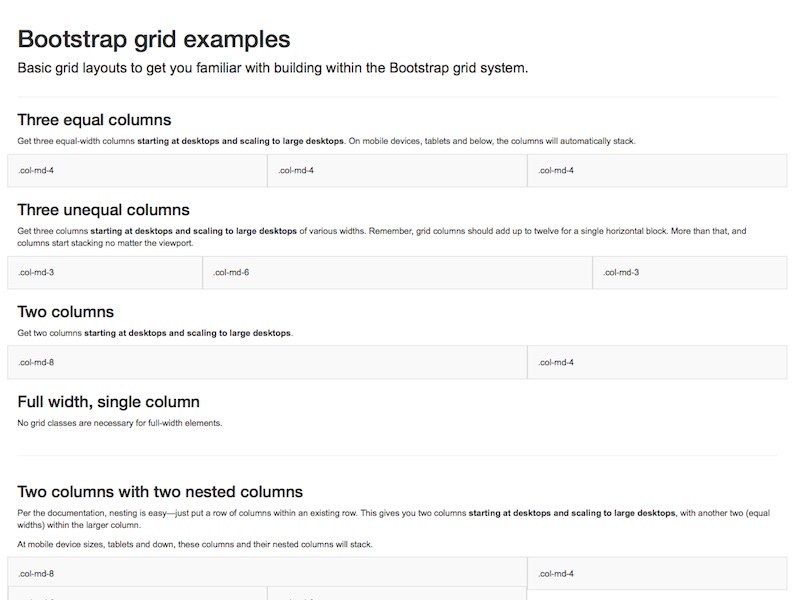

- #REACT BOOTSTRAP GRIDS EXAMPLE HOW TO#
- #REACT BOOTSTRAP GRIDS EXAMPLE INSTALL#
- #REACT BOOTSTRAP GRIDS EXAMPLE UPDATE#
We have built a real-time datagrid in React using react-table and Hamoni Sync. Hooray! We have a real-time editable datagrid with pagination! Conclusion Now we can start the React app and see our app in action! Run the command npm start in the command line and it'll open the application in your default browser. This should succeed and print out create success message. Open the command line and run node seed.js. Replace the AccountID and APP_ID string with your account and application ID. This will create a list primitive state on Hamoni Sync, with a name of datagrid.
#REACT BOOTSTRAP GRIDS EXAMPLE UPDATE#
Open the file src/App.js and update it with the code below: import React, ).

To render the datagrid, we will use the react-table component.
#REACT BOOTSTRAP GRIDS EXAMPLE INSTALL#
Run npm i react-table hamoni-sync in the command line to install both packages. Still on the command line, run cd realtime-react-datatable to switch to the directory for the app. With the React app created, we need to install react-table and Hamoni Sync. This will bootstrap a React application for us by creating a new directory realtime-react-datatable with the files needed to build a React application. Open the command line and run npx create-react-app realtime-react-datatable. If you have installed npm version 5.2.0 or greater, it installs npx alongside npm.įirst we will create a new React project using create-react-app. If you want to follow along, you should have some knowledge of React and have the following tools installed:
#REACT BOOTSTRAP GRIDS EXAMPLE HOW TO#
I will show you how to build a datagrid with people’s first and last names. Hamoni Sync is a real-time state synchronization service which enables you to synchronize your application state in real-time. React-table is a lightweight and fast library for rendering tables in React, and it supports pagination and many more features. In this article, I will show you how to build a real-time datagrid in React using react-table and Hamoni Sync. But what if you want the changes to be done in real-time and updates synchronized across all connected devices and their browsers? With those, you can add a Datagrid to your React app. Maybe you used libraries like react-bootstrap-table, react-grid, or react-table. You may have implemented this in one of your React apps in the past. This is a vital feature in most data-driven applications.

See also the example application below.By Peter Mbanugo How to Build a Real-time Editable Datagrid In ReactĪ datagrid enables you to display and edit data. This is useful for server-side rendering (SSR) based on the user agent. The screen class used when the view port cannot be determined using window. The default value is based on the Bootstrap 4 gutter width. A gutter width of 30 means 15px on each side of a column. The default values are based on the Bootstrap 4 container widths. The container widths in pixels of devices in screen class sm, md, lg, and xl. The default values are based on the Bootstrap 4 breakpoints. The breakpoints (minimum width) of devices in screen class sm, md, lg, and xl. An example on how to use them can be found in the Example application with SSR below. The following child context types can be provided to the grid components, to alter their responsive behavior. Next to that, the ScreenClassRender component is provided, for rendering a component differently based on the screen class. Paragraph hidden on extra small and small. Paragraph visible on extra small and small. Some examples on how to use these components: The main difference between these two components and the similar CSS classes provided by Bootstrap is that these two components do not render the content at all when it should be hidden, instead of just hiding it with CSS. Next to the grid, two components are provided for showing or hiding content: Visible and Hidden. Three components are provided for creating responsive grids: Container, Row, and Col.įor all features of these components, please have a look at the API documentation: Responsive utilities Moreover, it adds various powerful features, such as setting breakpoints and gutter widths through React's context. However, react-grid-system is purely React, even no CSS or class names are used. React-grid-system provides a responsive grid similar to Bootstrap (see: ).

Installation # Install react peer dependency


 0 kommentar(er)
0 kommentar(er)
